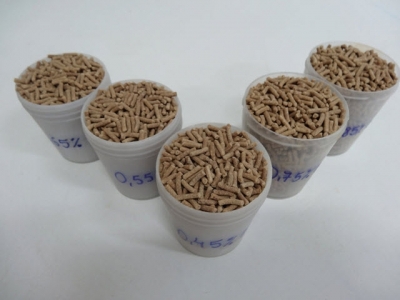Water exchange and dietary methionine requirement for juvenile Pacific white shrimp
The amino acid requirements of marine shrimp have been established using flow-through, clear-water culture systems – to provide maximum control over
 Research team unlocks way to use cheaper feed in shrimp production
Research team unlocks way to use cheaper feed in shrimp production The research team found that feed type used and the C/N ratio influenced biofloc development, water, quality, shrimp performance, feeding levels and production
 Comparing salinities in intensive, commercial-scale biofloc for Pacific white shrimp
Comparing salinities in intensive, commercial-scale biofloc for Pacific white shrimp Intensive, biofloc-based, minimal-water-exchange systems operate under low rates of water exchange, reducing or eliminating pollution from effluent
 Performance of Pacific white shrimp in biofloc with different light regimes
Performance of Pacific white shrimp in biofloc with different light regimes A biofloc technology system is one designed to increase productivity while improving the environmental control over production, and has reduced water exchange
 Automated feeding systems in pond production of Pacific white shrimp
Automated feeding systems in pond production of Pacific white shrimp The continued success of shrimp aquaculture will rely on improvements in feed management and reductions in the labor requirements for production.
 Assessment of supplemental Bacillus probiotics in whiteleg shrimp juveniles
Assessment of supplemental Bacillus probiotics in whiteleg shrimp juveniles Bacillus probiotics are spore-forming bacteria that are heat stable and are able to survive passage through the acidic stomach and make it to the gut
 Updates on shrimp diseases AHPND, NHP at Aquaculture America 2018
Updates on shrimp diseases AHPND, NHP at Aquaculture America 2018 A much-anticipated theme at the recent Aquaculture America 2018 was that of shrimp diseases.Many aquatic animal diseases caused by viruses, bacteria
 Natural strategies to improve growth and health of farmed shrimp
Natural strategies to improve growth and health of farmed shrimp Natural products like probiotics, prebiotics and lipopolysaccharides (LPS) have potential to improve growth and health of farmed shrimp.
 The importance of biosecurity and disinfection in aquaculture (Part 5)
The importance of biosecurity and disinfection in aquaculture (Part 5) Aquaculture - Biosecurity: The importance of biosecurity and disinfection in aquaculture (Part 5)
 The importance of biosecurity and disinfection in aquaculture (Part 4)
The importance of biosecurity and disinfection in aquaculture (Part 4) Aquaculture - Biosecurity: The importance of biosecurity and disinfection in aquaculture (Part 4)
 The importance of biosecurity and disinfection in aquaculture (Part 3)
The importance of biosecurity and disinfection in aquaculture (Part 3) Aquaculture - Biosecurity: The importance of biosecurity and disinfection in aquaculture (Part 3)
 The importance of biosecurity and disinfection in aquaculture (Part 2)
The importance of biosecurity and disinfection in aquaculture (Part 2) Aquaculture - Biosecurity: The importance of biosecurity and disinfection in aquaculture (Part 2)
 The importance of biosecurity and disinfection in aquaculture (Part 1)
The importance of biosecurity and disinfection in aquaculture (Part 1) Aquaculture - Biosecurity: The importance of biosecurity and disinfection in aquaculture (Part 1)
 EMS/AHPNS: Infectious disease caused by bacteria
EMS/AHPNS: Infectious disease caused by bacteria The shrimp-farming industry in Asia, the largest and most productive region in the world, was affected in 2009 by an emerging disease called early mortality
 Culture water pre-inoculation of probiotics in Pacific white shrimp nurseries
Culture water pre-inoculation of probiotics in Pacific white shrimp nurseries Culture water pre-inoculation of probiotics in Pacific white shrimp nurseries. Longer inoculation of probiotics improves postlarvae growth, survival
 White Spot Disease In Shrimp: How To Support Extensive Shrimp Farmers
White Spot Disease In Shrimp: How To Support Extensive Shrimp Farmers Shrimp aquaculture is a billion-dollar industry worldwide. It provides about half a billion dollars in export earnings, livelihood, and employment of millions
 Cargill seeks to support Vietnamese aquaculture development
Cargill seeks to support Vietnamese aquaculture development Cargill is focusing on shrimp production with a new research and demonstration facility in Bac Lieu, the shrimp farming hub of Vietnam.
 Alternative feed protein may boost shrimp survival, weight gain
Alternative feed protein may boost shrimp survival, weight gain Calysta is testing its natural gas derived protein in shrimp diets and it says initial results suggest that the ingredient supports shrimp survival and producti
 Demand feeding through automatic dispensing systems
Demand feeding through automatic dispensing systems Appropriate knowledge of the feeding equipment used, with its correct location in the shrimp pond, results in the maximum benefit of the aquaeed supplied.
 Potential applications of bacteriophages for AHPND control
Potential applications of bacteriophages for AHPND control Isolated phages evaluated effective in controlling major farmed shrimp disease, inhibiting bacterial growth
